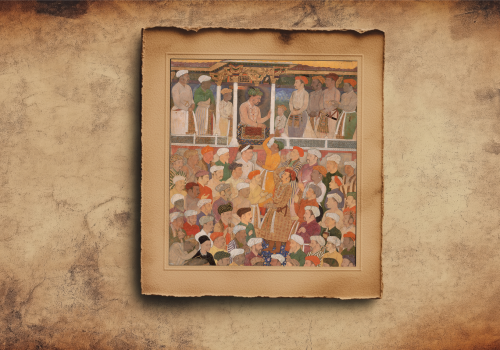A sizable portion of the book is in verse. The historical information it contains appears to be based on personal knowledge of the author and is on the whole correct and useful. The Zafarnamah (lit. record of victories) opens with invocation to God followed by a qasidah or panegyric in praise of the book\’s protagonist. Mu\’in ul-Mulk, known to Sikh chroniclers as Mir Mannu, was the son of Wazir Qarnar ud-Din, the prime minister of the Mughal emperor Muhammad Shah. When Ahmad Shah Durrani invaded India for the first time at the head of fifty thousand horsemen, early in January 1748, Shah Nawaz Khan, governor of Lahore and Multan, fled to Delhi offering only a feeble resistance and the invader occupied Lahore which, says the author, was subjected to thorough plunder, a part of it being set on fire.
Emperor Muhammad Shah sent a huge force led by Wazir Qamar ud-Din under the nominal command of the crown prince, Ahmad Shah, to drive away the invader. Mu\’in ul-Mulk accompanied his father. In the beginning of the batde fought at Manupur, 15 km northwest of Sirhind, Qamar ud-Din was mortally wounded by a cannon shot. Mu\’in ul-Mulk at once took command of the situation. Suppressing his filial tears, he hurriedly buried his father\’s dead body in the floor of his sleeping tent, levelling it over with sand, and launched a fierce attack against the enemy lines. A severe battle followed resulting in heavy casualities on both sides but it ended in victory for the Mughals.
The Durrani quietly retreated during the night to Lahore and thence to his own country. During his return journey he was constantly harassed and looted by the Sikhs. Just during this time news arrived of imminent death of the emperor at Delhi. Prince Ahmad Shah, directing Muin ul-Mulk to take charge as governor of Lahore and Multan, hastened back to Delhi, where he succeeded to the throne of his father who had expired before the son\’s arrival in the capital. Muin ul-Mulk came to Lahore and immediately attended to the shattered civil administration of the province and provided relief to the oppressed populace. He replaced Lakhpat Rai by Kaura Mall as his diwan and coniimed Adina Beg Khan in the faiijdan of Jalandhar Doab.
Ahmad Shah Durrani descended upon the Punjab for the second time in December 1748. Muin ul-Mulk promptly sent forth a strong force which faced the invading horde on the bank of the River Chenab. Ahmad Shah offered to go back if the Punjab governor paid the arrears and undertook regular payment in future of the revenue of four mahals or districts of Gujrat, Aurangabad, Sialkot and Pasrur which he claimed had been assigned to Nadir Shah and were legitimately his now. Muin ul-Mulk wrote back that it was stupid to engage in a battle where Muslims would be killed on both sides. He prudently agreed to pay the dues, and Ahmad Shah returned to Qandahar.
References :
1. Kirpal Singh, ed., A Catalogue of Persian and Sanskrit Manuscripts. Amritsar, 1962


